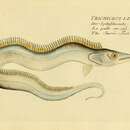Description
provided by World Register of Marine Species
Occurs on continental shelf, occasionally in shallow waters and at surface at night. Generally found on muddy bottoms of shallow coastal waters and may often penetrate estuaries (Ref.9351). Immature fish feed mostly on euphausiids, small pelagic planktonic crustaceans, small fishes while adults feed on anchovies, sardines, myctophiids etc. and occasionally on squids and crustaceans. Adults and juveniles have opposing complementary vertical diurnal feeding migration. Large adults usually feed on pelagic prey near the surface during the daytime and migrate to the bottom at night. Juveniles and small adults form schools 100 m above the bottom during the daytime and form loose feeding aggregations at night-time near the surface where they prey on planktonic organisms. Caught in estuaries and offshore waters throughout the world (Ref. 9688). Also caught with encircling nets (Ref. 9351). Marketed salted/dried and also frozen (Ref. 9351). Excellent taste when fried or grilled; also for sashimi when fresh.
Froese, R. & D. Pauly (Editors). (2023). FishBase. World Wide Web electronic publication. version (02/2023).
- license
- cc-by-4.0
- copyright
- WoRMS Editorial Board
Distribution
provided by World Register of Marine Species
Worldwide distribution, except eastern Pacific, in warm seas. Western Atlantic north to Massachusetts, common from Chesapeake Bay south.
North-West Atlantic Ocean species (NWARMS)
- license
- cc-by-4.0
- copyright
- WoRMS Editorial Board
Habitat
provided by World Register of Marine Species
nektonic
North-West Atlantic Ocean species (NWARMS)
- license
- cc-by-4.0
- copyright
- WoRMS Editorial Board

